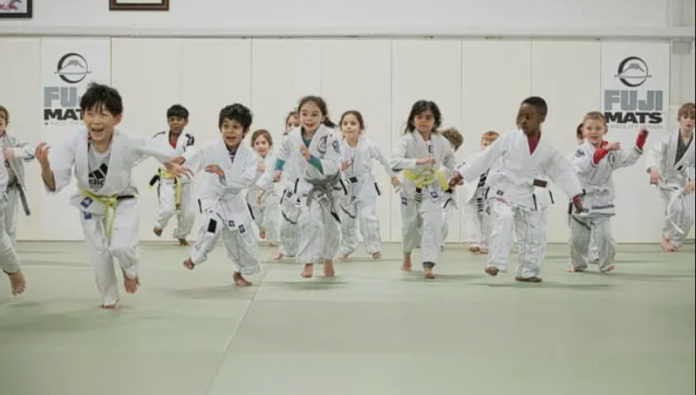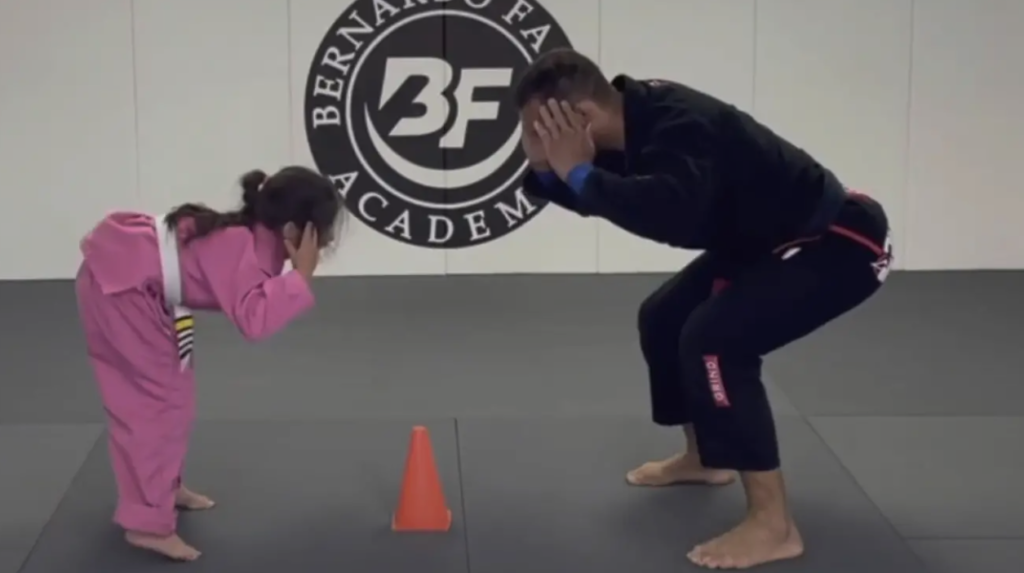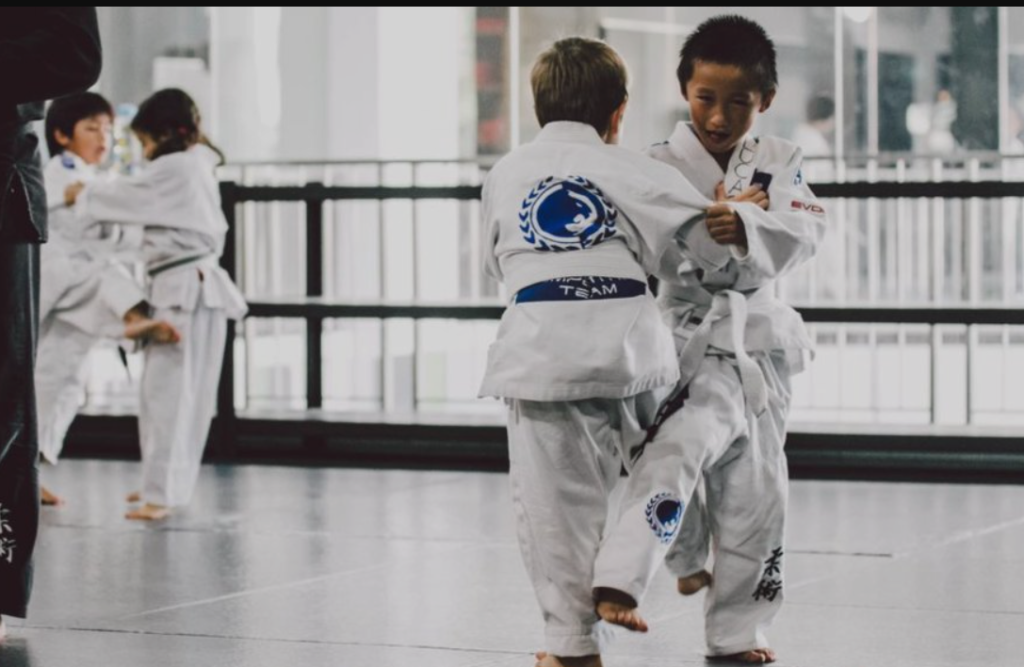
Brazilian Jiu-Jitsu is a martial art that has gained popularity among kids in recent years. It’s an effective way to improve fitness, build self-confidence, and learn self-defense skills. However, Jiu-Jitsu training can sometimes be challenging for kids, and they may lose interest or become discouraged. That’s where Jiu-Jitsu games come in. These games are fun, engaging, and help kids develop their technique and skill in a supportive environment. In this article, we’ll explore the benefits of BJJ games for kids and provide tips on how to play them effectively.
The 42 Best Jiu-Jitsu Games For Kids
1. Dodge Ball
This is a fun game that can improve kinesthetic awareness and keep kids interested in physical activity. The game involves throwing a ball at other players, who must either avoid getting hit or catch the ball. Players who get hit are out of the game, but if the person who got them out gets hit later, they can come back in. Dodge Ball can also help develop mobility skills and requires players to pay attention to who gets them out.
2. Red Light-Green Light
A game that can be played while standing or crawling. Using the commands “go” and “freeze,” players must freeze or move forward depending on the direction given. This game can help improve reaction time and listening skills.
3. Clothes Pin Grab
Players try to grab clothes pins off of each other’s backs. If someone gets your clothes pin, you’re out of the game. This game can teach players to stay face to face with each other and to practice gripping techniques by placing the clothes pins on different parts of the body.
4. Tail Belt Grab
Is a game where players remove their belts and stick them in the back of their pants like a tail. The goal is to grab other players’ belts and pull them off. If your belt is pulled off, you’re out of the game. This game can improve agility and reflexes.
5. Sumo
In this game players use belts tied together to create a ring. The objective is to push or pull opponents out of bounds or down to their knees. This game can teach players about balance and momentum while also providing a fun and engaging way to stay active.
6. Freeze Tag
Players have to run from one side to the other, while one person is chosen to be “it” and stays in the middle. If the “it” person touches a player, that player is frozen and cannot move until someone crawls under their legs or performs a specific BJJ move move to unfreeze them.
7. Crab Roll
For older kids, the game involves crawling from one side to the other, but if a player gets rolled and pinned by another player, they are out of the game.
8. Circle Of Knowledge
one of the most important Jiu-Jitsu games for kids, players make a big circle and jog in place while a BJJ-related question is asked, such as “Who founded Jiu-Jitsu?” or “What does Kimura mean?” Players who answer correctly get to stay in the game or move to the front of the line, while those who answer incorrectly must do pushups or situps.
9. Dice Roll
This game involves using fluffy dice with numbers and Brazilian Jiu-Jitsu techniques printed on them. Players roll the dice and then perform the corresponding number of pushups or the technique indicated by the dice.
10. Simon Says
Is played with a game structure, where players follow the leader’s movements. The movements may include hands and knees, break falls, shrimping, bridging, roll over, technical stand up, sit outs, and sit cross-legged. The pace gradually increases to get the players sweaty.
11. Belt Hide and Seek
Divide into two teams and have them sit facing each other on the mat. One team will have a belt or ball and secretly hide it on one of their members. The other team must try to get the person with the hidden item to cross over to their side safely while only using crab or butt scooting. The team with the hidden item can try to trick the other team by pretending that someone else has the item.
12. Butt Ball
Form teams and use a light or heavy ball to try and get it over to the other side while only using butt scooting. Players can roll the ball on the floor but cannot throw it.
13. Snake Tag
Have everyone form a long line holding the waist or belt of the person in front of them. One person is left off the line and faces the first person in the line. The kid off the line tries to touch the last person in the snake line, while the others move to protect the “tail of the snake”. Switch the kid who is off the line when they succeed or after two minutes.
14. Reverse Crab Crawl
Crawl up and down the floor on hands and feet, going backward and forward. Players should switch between bear walk and crab crawl by replacing diagonal hands and feet. When advancing, players should always be in bear walk position, and crab crawl is only used for transitioning.
15. Centipede
Group 2 or 3 kids (or more) together and sit one behind the other. Players should hold the ankles of the person behind them and scoot on their butt up and down the mat. Players can also play Snake Tag in this format.
16. Chicken Fight
Everyone gets a partner. One person piggybacks on the other, and each pair has to knock the other pairs off the back of their partners. The last pair left standing wins.
17. Whip Belt
Everyone gets a partner. One person takes off their belt, and the other lays down flat on their back. The person with the belt tries to hit the person on the floor (not too hard), and the person on the floor has to roll out of the way and then roll back into the initial position. The standing person tries to fake and the person on the floor tries to read their body movements.
18. Belt Jump Rope
Assign partners and have them take off their belts. Tie the belts together and use them as a jump rope. One person starts, and then the partner tries to jump in as the rope is moving.
19. Floor Rope Climb
Get a partner and take off your belts. One person lies flat on their back with their legs in the air, holding one end of the belt with their head facing their sitting partner. The sitting partner sits with their legs spread, facing the person on the floor.
The person on the floor pulls themselves towards the sitting partner by hand over hand on the belt without using their legs for help. The sitting kid can wrap one end of the belt around their waist for support if needed. Then switch and have the sitting partner pull the person on their back towards them.
20. Mountain Climb
A partner exercise suitable for two adults or older children. They face each other and interlock their arms by placing their hands on the other person’s shoulders. They bend their knees and lower their heads, so they resemble sumo wrestlers looking down at the ground.
The first participant in the line then jumps onto the back of “Mountainside 1” and attempts to move around the side of the mountain, using hand grips and feet positions, without touching the floor until they return to the starting position, on Mountainside 1’s back. This exercise can also be performed by going over the mountain.
Begin by jumping onto Mountainside 1’s back, pulling yourself up until you’re on top of the mountain, then go down headfirst on Mountainside 2’s back and up under their legs until you’re looking up at the two holders’ faces. Finally, go up in between Mountainside 1’s legs and back into the original position on their back.
21. Shoulder Touches
One person sits in a Judo guard position on the ground, while the other stands in front of them. The standing person’s objective is to touch the shoulders of the person on the ground, while the person on the ground must use their legs and butt to face the standing person and prevent them from touching their shoulders.
22. Blind Push Balance Exercise
Form groups of five individuals. One person stands in the middle with their eyes closed, while the other four people surround them, creating four walls. The four individuals in the outer circle firmly push the person in the middle, and the person in the middle must regain their balance and square up to the person who pushed them with their hands up in a fighting position. Start with open eyes and progress to closed eyes.
23. Ankle Flip
This game is for adults and older kids. Find a partner and stand facing forward. One partner does a handstand close to the other partner, ending up back to back, with the other partner standing. The standing partner then grabs the ankles of the handstanding partner.
The handstanding partner, with their partner gripping their ankles, performs a sit-up and flips over their partner’s back, landing on their feet on the mat in front of their partner. Ensure that the partner standing is stable and leaning forward to avoid falling backward. The ceiling should be high enough, and mats should be used.
24. Pushup Tunnel
All the kids get in a pushup position next to each other, facing the same direction. They raise their butts in the air, and the last person in line crawls under everyone to the other side and assumes the pushup position to keep the tunnel the same length. one fo the best strength and conditioning Jiu-Jitsu games for kids that the children love doing.
25. Leap Frog Exercise
In this game, partners leapfrog down the mats. They can also perform static leaps over their partners while their partner is bent over, and the partner stands up while they crawl under their legs. The entire class can also form a continuous moving circle. Everyone gets in a leapfrog position in a circle, either standing and bent at the waist or sitting in a ball for younger kids. The person on the end gets up and leapfrogs over the next person, and this continues until they have gone over everyone. After the first person goes, the person they first jumped over goes, and so on.
26. Crash Mat Flip
In the game, a crash mat is used to hold the kids by their lapels while they lean back as if they are going to fall on the crash mat on their backs. Once they are in position, let go of them, and they will spin and land on their forearms on the crash mat. For younger children or those doing it for the first time, it’s important to let them know when you’ll let go so they can be prepared.
27. Animal Cards
A game where cards with pictures of animals (such as tigers, snakes, monkeys, and cranes) are used. Half of the group looks at the card, while the other half picks one of the cards and has to run to the person who acts like the animal on their card. Alternatively, all the participants can be assigned a certain animal and they have to try to find others who have the same animal.
28. Speed Tag
The objective here is to run and tag as many people as possible. The instructor will tell the players which body part to tag (e.g. right shoulder, left knee, right thigh) and they need to try to tag as many people as they can.
29. Wheel Barrel
This is a game where one person gets down on the floor in a push-up position while the second person comes from behind and picks up their feet. The person on the floor moves forward on their arms while the other person holds their feet.
30. Obstacle Mitts
Mitts are placed on the floor to create an obstacle course. Participants need to touch specific mitts with certain body parts (e.g. right elbow to red mitts, jump over blue mitts) in order to complete the course.
31. Run and Collect
The objective of the game is to collect as many ropes as possible without losing one’s own rope.
32. Black/White Catch Game
Is a game where everyone lies in the middle of the hall, head to head. When black is called, the black team needs to run to the safety area as soon as possible, while the white team tries to catch the black team members.
33. Rock/Paper/Scissors
In it, there are two teams. Each team decides on three selections and comes together. The winning team then tries to catch the losing team.
34. Dice
The game involves each team rolling a die at each corner and doing the specified movement that fits the die to the next corner. For example, 1 could mean a forward stance, 2 could mean a forward stance and lower block, and 6 could mean a jump back sidekick. The higher the value on the die, the more difficult the movement. The team that gets to a certain value, such as exactly 15, is the winner.
35. Atom Split
In this game, one person catches the second person, the second person catches the third person, and the third person catches the fourth person. Then the group splits into two groups of two, and they run together while holding hands.
36. Steal Belts
A game where the objective is to take your partner’s belt away from them while on the mats.
37. Quick Slap
In quick slap, hands are placed over a partner’s hands, and the objective is to try to slap the top of the partner’s hand with your right hand while they try to move their hand out of the way.
38. Pushing Fake
For this one, participants are in a rectangular stance facing their partner. The objective is to try to take the other person off balance using a combination of slaps, pushes, and fakes.
39. Face Slapping
In the game, participants work with a partner, with one person slapping (ina controlled way) and the other moving their head in the direction of the force of the slap.
40. Vertical Rope Swing
The game involves standing facing your partner and swinging your belt vertically at your partner’s head, while they move out of the way by pivoting their head. The game can also be played horizontally, with participants ducking and jumping, and can be done with a tambo as well.
41. Monkey In The Middle
This activity involves a person in the center who must run to partner 1, execute a judo throw or self-defense technique, and then run back to partner 2 to repeat the same process. The goal is to get them moving while performing self-defense or judo techniques, increasing their cardio workout.
42. The Technician
The final in our list of Jiu-Jitsu games for kids is a game played with a group of three, where one person is the technician, and the other two are robots. The technician’s objective is to direct the robots back to the same starting point. For example, if the technician touches the robot’s right shoulder, it must turn right by 90 degrees and perform a lower block. Similarly, if the technician touches the left shoulder, the robot must turn left by 90 degrees and execute a left lower block, and so on.
Benefits Of Jiu-Jitsu Games For Kids
Jiu-Jitsu games provide a fun and engaging way for kids to develop their technique and skill in a supportive environment. These games also help kids enhance their problem-solving abilities, improve timing and reaction, build self-confidence and self-esteem, and foster teamwork and social skills.
Develop Technique And Skill
BJJ games also provide a fun and interactive way for kids to practice their techniques and skills. By including games into their training, kids can improve their movement, coordination, and timing while having fun. This can help them build a solid foundation for their jiu-jitsu practice and make progress more quickly.
Enhance Problem-Solving Abilities
Grappling games often require kids to think creatively and solve problems. By facing different challenges and situations, they learn to adapt and find solutions to overcome obstacles. This can help them develop critical thinking skills that are useful not only in Jiu-Jitsu but also in other areas of their lives.
Jiu-Jitsu games To Improve Timing And Reaction
Timing and reaction are essential skills in Jiu-Jitsu. Games that focus on these skills can help kids improve their reflexes and response time. This can make them more effective in their Jiu-Jitsu practice and also help them react more quickly to unexpected situations in their daily lives.
Build Self-Confidence And Self-Esteem
Jiu-Jitsu games can help kids build their self-confidence and self-esteem. By succeeding in different challenges and games, kids learn to believe in themselves and their abilities. This can translate into other areas of their lives, where they may feel more confident and capable, like fending off bullies.
Foster Teamwork And Social Skills
Participating in certain Jiu-Jitsu games requires kids to work together as a team. This can help them develop social skills such as communication, cooperation, and respect for others. It also creates a supportive and encouraging environment where kids can make friends and learn from each other.
How To Play Jiu-Jitsu Games With Kids
Jiu-Jitsu games can be a great way to keep kids interested and motivated in their training while having fun at the same time. However, it’s important to understand the rules of the game, create a safe environment, and adjust the difficulty level to match the kids’ skill level to ensure a positive experience.
Understanding The Rules Of The Game
Before playing any Jiu-Jitsu game with kids, it’s essential to explain the rules and objectives clearly. This helps kids understand what they need to do and how to play the game. It also ensures that everyone is on the same page and can play the game safely and effectively.
Creating A Safe Environment
Safety should always be a top priority when playing Jiu-Jitsu games with kids. Make sure that the area is free from hazards and that the kids have appropriate protective gear. You should also supervise the games to ensure that everyone is playing safely and following the rules.
Keeping Jiu-Jitsu Games Fun And Engaging
Jiu-Jitsu games should be fun and engaging to keep kids motivated and interested. Try to choose games that are challenging but not too tricky, and incorporate different elements of play such as competition, cooperation, and creativity.
Adjusting The Level Of Difficulty
It’s important to choose games that match the kids’ skill level. If the games are too easy, they may become bored, and if they are too difficult, they may become discouraged. Try to choose games that challenge them while still allowing them to succeed and improve their skills.
Incorporating Games Into Regular Jiu-Jitsu Training For Kids
Incorporating games into regular Jiu-Jitsu classes for kids can make the training more fun and engaging. It can help kids develop their technique and skill while enjoying themselves. Games can also provide a break from traditional training methods and keep kids motivated and interested in their BJJ practice.
Conclusion
These 42 best Jiu-Jitsu games for kids offer a fun and interactive way to learn the art while also benefiting from the many advantages of gameplay. From enhancing problem-solving abilities and reaction timing to building self-confidence and teamwork skills, Jiu-Jitsu games provide numerous benefits for young practitioners. To ensure the best possible experience, it’s important to understand the rules of each game and create a safe environment for your child to play in. Additionally, keeping the games fun and engaging while adjusting the level of difficulty and incorporating them into regular training sessions can help maximize their effectiveness.
















































